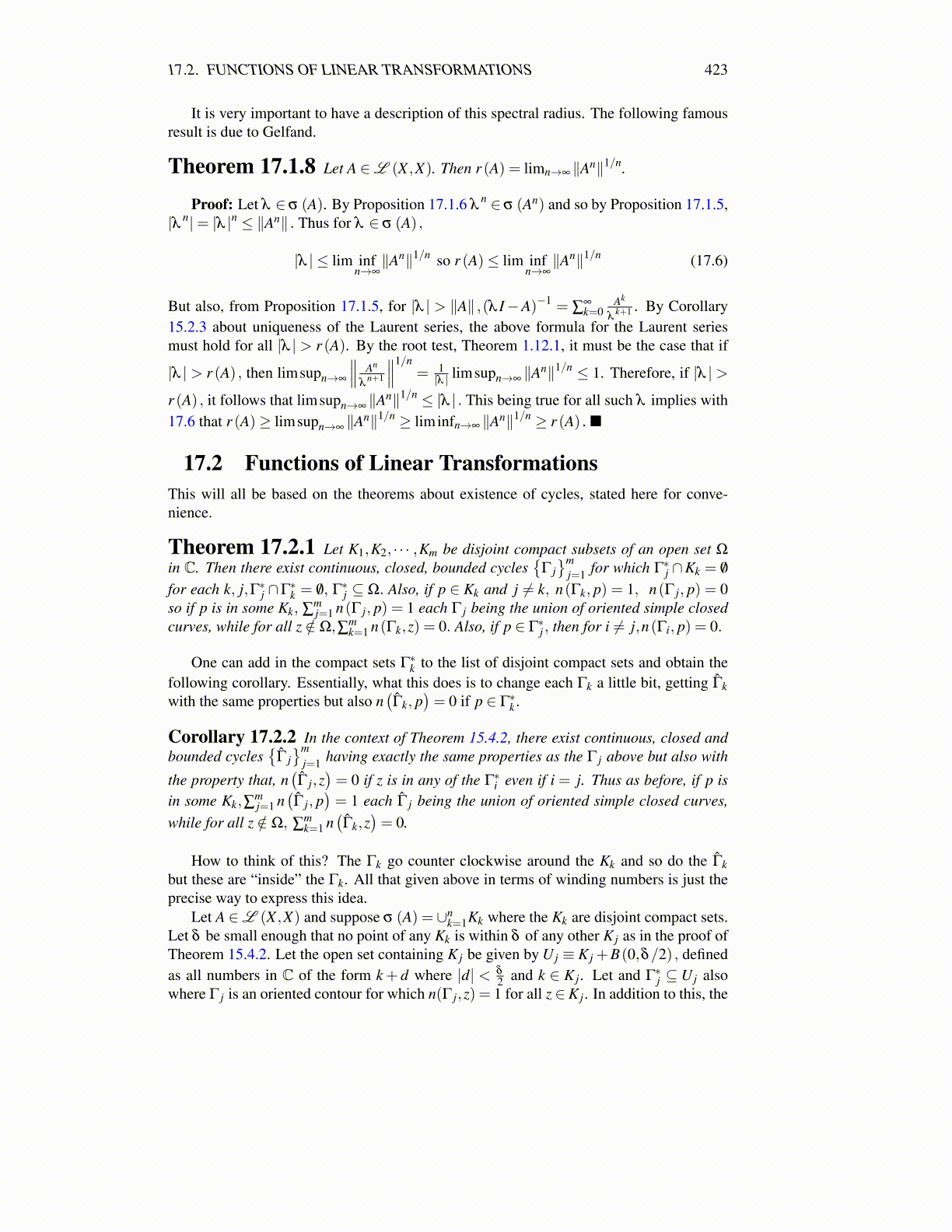
17.2. FUNCTIONS OF LINEAR TRANSFORMATIONS 423
It is very important to have a description of this spectral radius. The following famousresult is due to Gelfand.
Theorem 17.1.8 Let A ∈L (X ,X). Then r (A) = limn→∞ ∥An∥1/n.
Proof: Let λ ∈ σ (A). By Proposition 17.1.6 λn ∈ σ (An) and so by Proposition 17.1.5,
|λ n|= |λ |n ≤ ∥An∥ . Thus for λ ∈ σ (A) ,
|λ | ≤ lim infn→∞∥An∥1/n so r (A)≤ lim inf
n→∞∥An∥1/n (17.6)
But also, from Proposition 17.1.5, for |λ | > ∥A∥ ,(λ I−A)−1 = ∑∞k=0
Ak
λk+1 . By Corollary
15.2.3 about uniqueness of the Laurent series, the above formula for the Laurent seriesmust hold for all |λ | > r (A). By the root test, Theorem 1.12.1, it must be the case that if
|λ | > r (A) , then limsupn→∞
∥∥∥ An
λn+1
∥∥∥1/n= 1|λ | limsupn→∞ ∥An∥1/n ≤ 1. Therefore, if |λ | >
r (A) , it follows that limsupn→∞ ∥An∥1/n ≤ |λ | . This being true for all such λ implies with17.6 that r (A)≥ limsupn→∞ ∥An∥1/n ≥ liminfn→∞ ∥An∥1/n ≥ r (A) .■
17.2 Functions of Linear TransformationsThis will all be based on the theorems about existence of cycles, stated here for conve-nience.
Theorem 17.2.1 Let K1,K2, · · · ,Km be disjoint compact subsets of an open set Ω
in C. Then there exist continuous, closed, bounded cycles{
Γ j}m
j=1 for which Γ∗j ∩Kk = /0for each k, j,Γ∗j ∩Γ∗k = /0, Γ∗j ⊆ Ω. Also, if p ∈ Kk and j ̸= k, n(Γk, p) = 1, n(Γ j, p) = 0so if p is in some Kk, ∑
mj=1 n(Γ j, p) = 1 each Γ j being the union of oriented simple closed
curves, while for all z /∈ Ω,∑mk=1 n(Γk,z) = 0. Also, if p ∈ Γ∗j , then for i ̸= j,n(Γi, p) = 0.
One can add in the compact sets Γ∗k to the list of disjoint compact sets and obtain thefollowing corollary. Essentially, what this does is to change each Γk a little bit, getting Γ̂kwith the same properties but also n
(Γ̂k, p
)= 0 if p ∈ Γ∗k .
Corollary 17.2.2 In the context of Theorem 15.4.2, there exist continuous, closed andbounded cycles
{Γ̂ j}m
j=1 having exactly the same properties as the Γ j above but also with
the property that, n(Γ̂ j,z
)= 0 if z is in any of the Γ∗i even if i = j. Thus as before, if p is
in some Kk,∑mj=1 n
(Γ̂ j, p
)= 1 each Γ̂ j being the union of oriented simple closed curves,
while for all z /∈ Ω, ∑mk=1 n
(Γ̂k,z
)= 0.
How to think of this? The Γk go counter clockwise around the Kk and so do the Γ̂kbut these are “inside” the Γk. All that given above in terms of winding numbers is just theprecise way to express this idea.
Let A ∈L (X ,X) and suppose σ (A) = ∪nk=1Kk where the Kk are disjoint compact sets.
Let δ be small enough that no point of any Kk is within δ of any other K j as in the proof ofTheorem 15.4.2. Let the open set containing K j be given by U j ≡ K j +B(0,δ/2) , definedas all numbers in C of the form k+ d where |d| < δ
2 and k ∈ K j. Let and Γ∗j ⊆ U j alsowhere Γ j is an oriented contour for which n(Γ j,z) = 1 for all z ∈ K j. In addition to this, the